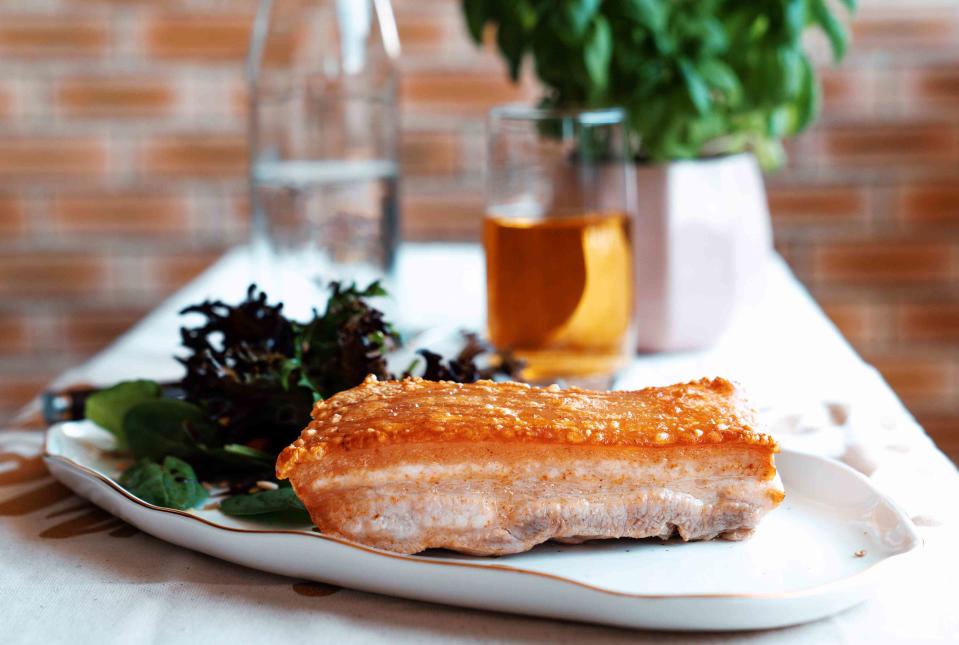A Guide to Pork Belly, the Trendy Cut You Can Prepare at Home
You’ve seen it on menus, here’s an introduction to cooking pork belly at home.

wenyi liu / Getty Images
There is a delightful appetizer at Gris Gris in New Orleans that I love: seared pork belly braised in root beer and served over a watermelon round. The last time I went, a patron sitting next to me inquired about the glistening hunk of meat sitting atop the juicy fruit. It dawned on me that even though I’ve seen pork belly dishes on many menus before this one, its growing popularity doesn’t negate the fact it’s less recognizable than other cuts. With that in mind, here's everything you need to know about sourcing and cooking with pork belly.
What is pork belly?
Aptly named, pork belly comes from the underside of a pig and is the remaining boneless slab of meat after a butcher removes the loins and spare ribs. According to a National Library of Medicine study, unprocessed pork belly contains about 48% fat, giving it a rich flavor. It’s also the source of other widely used cuts of pork, like bacon and pancetta.
Is pork belly the same as bacon?
It's a common misconception, but pork belly and bacon are, in fact, different. Pork belly refers to the raw, unsmoked, and uncured whole slab of meat cut from the pig's underside. Though bacon can come from various places like the pig's back or sides, most American grocery stores stock streaky bacon — the sliced, cured, and smoked product cut from the pork belly slab. Pancetta originates from Italy and is also from pork belly, but unlike bacon, it is cured and dried.
How do I cook pork belly?
There are several ways to cook pork belly, including roasting, pan frying, smoking, and grilling. Since pork belly has a high fat content, most recipes call to break down the excess collagen in the meat. You can do this with a low-and-slow cooking method like braising. Some chefs like to start by searing the meat before slowly simmering it in liquid at low temperatures. Why? Scraping up the remaining browned bits (called fond) at the bottom of the pan from the sear lends the braising liquid a deeper flavor. For her Thit Ko (Vietnamese Braised Pork Belly) , chef and cookbook author Diep Tran sears her pork belly in a ripping hot pan. Then she cooks her aromatics in the rendered fat before returning the pork belly and covering it with water to simmer. However, you don’t always need to sear before braising. Two-time Top Chef winner Buddha Lo skips searing for his Emperor’s Pork. He adds the pork belly directly into a pot with tons of liquid seasonings like soy sauce, Shaoxing wine, and spices including MSG to cook slowly until tender. A heavy-bottom pot, like a Dutch oven, is ideal for braising, but a pressure cooker is also a handy appliance to cut down on some cooking time.
Methods like smoking and grilling still work with pork belly, but it’s a good idea to trim the fat cap before the meat hits the grill to prevent flare ups. Unlike working with a larger slab, F&W Food Editor Paige Grandjean calls to trim the fat cap and cut the pork belly into small pieces in this Pork Belly Burnt Ends with Barbecue Sauce recipe.
Another thing people love about pork belly recipes is a crispy skin. Since most recipes call for skinless pork belly, generously salting the meat before it roasts in an oven creates a salt crust like the one on these Adobo Pork Belly Nigiri. The salt crust draws out extra moisture and helps achieve a crisper crackling.
Where can I buy pork belly?
With its increasing popularity, pork belly can be bought at most major grocery stores and specialty butcher shops. Asian or Mexican grocery stores are also good places to check. You can also buy pork belly from many reputable online stores, such as wildforkfoods.com.
For more Food & Wine news, make sure to sign up for our newsletter!
Read the original article on Food & Wine.


